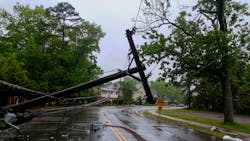Are we taking a flawed approach to improving system resilience? Recent major weather events have motivated us to improve electric system resilience, but are we doing that as well as we could?
North American reliability — the degree to which the system delivers electric power within nominal parameters in the face of predictable, small-scale events like faults — is very good by design, and through the efforts of our operations teams. How quickly we can restore power when large elements of the system are taken out by a low probability (or low frequency) catastrophic event is a different matter.
System resilience is currently improved through one or both of these mechanisms:
- Restoring the system quickly if it gets knocked down
- Making it harder to knock down.
Much sweat and treasure have gone into both measures. But we could take a new approach to planning and prioritizing system investments and produce an electric power system that is faster to restore after a catastrophe.
Our interest in this subject was piqued a few years back when a client in the Pacific Northwest brought an earthquake/tsunami scenario to our attention. The Cascadia Subduction Zone (CSZ) lies off the Pacific coast of Washington, Oregon, and Northern California. Briefly, the geologic record of the last 10,000 years shows that on a reasonably periodic basis, the CSZ fault throws a massive earthquake. On average time-scales, an earthquake is overdue. Record shows that the longer it tarries, the larger it’ll be when it arrives. The resulting damage to homes and infrastructure in coastal Oregon and Washington, Oregon’s Willamette Valley, and Washington’s Puget Sound is predicted to be devastating and may take months or years to restore. The magazine article, “The Really Big One,” The New Yorker Magazine, Kathryn Schulz, July 13, 2015, offers a clear presentation of the CSZ fault’s recent geologic history.
During the period after the earthquake event, it may be feasible to operate small portions of the electric power system as isolated sub-grids if certain technical and operational preparations are made ahead of the earthquake. We believe that these mitigations are worthwhile in other parts of the power system. Further, they will permit the power system to be more reliable and resilient under normal contingencies.
Here are the steps needed to prepare a system to recover quickly from a catastrophic event that isolates a region from the rest of the bulk electric system (BES):
- Scenario planning: Identify likely high-impact scenarios and power system assets that can be expected to survive the event largely intact. Include major loads, generation sources, and the transmission and distribution facilities that can connect them with each other. Depending on the nature of the scenarios examined, certain sources, loads, lines, and substations may be more likely to ride out the catastrophe without major damage. Earmark those assets for priority preparation efforts.
- Stability modeling: Examine sub-grid voltage and frequency stability in several repair stages, from immediately following the event through several islanded and mini-grid topologies, to reconnection to the BES. Note that some degradation of ‘normal’ parameter windows can probably be tolerated during the recovery period.
- Black start identification: Document the generation assets in each sub-grid that can be black started. Add black start capability to critical sources. When more generation assets can be black started, it is more likely a surviving generation source can be available to initiate sub-grid restoration after a catastrophe.
- Temporary generation support: Add bays to selected sites and substations that permit rapid connection of temporary generation. Portable generation assets can be deployed from secure, local stores or brought from out of the region after an event. These can support critical or local ancillary loads, help with grid-forming activities, or provide synching voltage to distributed renewables.
- Controls identification: Identify system controls that need to be added to the system. These should permit synchronized closing, generator paralleling, and other routine operations in non-routine topologies. Backup SCADA, communication channels, and sub-grid generation controls may be necessary.
- Operations support: Prepare emergency operating procedures. They must be available and crystal clear. Staff will be operating at less than full-capacity, under extreme pressure, and with a high degree of distraction because of the personal impacts of the event. Some may be unfamiliar with the system since they were brought in from elsewhere to assist on a temporary basis.
Any place that can experience events which would leave a partially functioning distribution and sub-transmission system isolated from the larger BES is a candidate for these activities. The opportunity to make the fully connected system more robust and flexible is a useful ancillary benefit.
To animate these system investments, regulators should establish the system planning activities that identify and prioritize investments. Second, incentives and/or investment cost recovery mechanisms could also be required, which will lead finally to the projects.
While events like the CSZ earthquake and tsunami are rare in North America, there are several regions where significant natural and man-made exposures exist. We can hope that these investments would never be called into action to recover from such devastating scenarios. However, experience suggests that hoping isn’t as productive an activity as preparing.
About the Author
John J. Kumm
John J. Kumm is vice president for field services at POWER Engineers, Inc. His current responsibilities include overseeing POWER Engineers' substation testing team. With more than 30 years in the electric utility business, Kumm has specialized in protective relay design, application, and testing, with interest in power system reliability, human performance improvement (HPI), and executive coaching.
